List of heads of state of Spain
This is a list of Spanish heads of state, that is, kings and presidents that governed the country of Spain in the modern sense of the word. The forerunners of the Spanish throne were the following:
.svg.png.webp) |
|---|
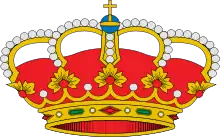
These lineages were eventually united by the marriage of the Catholic Monarchs, Ferdinand II of Aragon (king of the Crown of Aragon) and Isabella I of Castile (queen of the Crown of Castile). Although their kingdoms continued to be separate, with their personal union they ruled them together as one dominion. Spain was thereafter governed as a dynastic union by the House of Trastámara, the House of Habsburg, and the House of Bourbon until the Nueva Planta decrees merged Castile and Aragon into one kingdom.
During the First Spanish Republic (1873–1874), Spain had heads of state known as the President of the Executive Power. However, it is only during the Second Spanish Republic (1931–1939) that the official title of President of Spain (or President of the Republic) existed. Today, Spain is a constitutional monarchy, and there is thus no person holding the title of President of Spain. However, the prime minister holds the official title of President of the Government.
Kingdom of Spain (1479–1873)
House of Trastámara (1479–1555)
Under Isabella and Ferdinand, the royal dynasties of Castile and Aragon, their respective kingdoms, were united into a single line. Historiography of Spain generally treats this as the formation of the kingdom of Spain, but in actuality, the two kingdoms continued for many centuries with their own separate institutions. It was not until the Nueva Planta decrees of the early 18th century that the two lands were formally merged into a single state.
| Name | Lifespan | Reign start | Reign end | Notes | Family | Image |
|---|---|---|---|---|---|---|
Isabella I
| 22 April 1451 – 26 November 1504 (aged 53) | 11 December 1474 Castile | 26 November 1504 Castile | Daughter of John II of Castile and Isabella of Portugal | Trastámara |  |
Ferdinand V & II
| 10 March 1452 – 23 January 1516 (aged 63) | 15 January 1475 Castile 20 January 1479 Aragon | 26 November 1504 Castile 23 January 1516 Aragon | Son of John II of Aragon and Juana Enríquez | Trastámara |  |
Joanna
| 6 November 1479 – 12 April 1555 (aged 75) | 26 November 1504 Castile 23 January 1516 Aragon | 12 April 1555 | Daughter of Isabella I of Castile and Ferdinand II of Aragon | Trastámara | 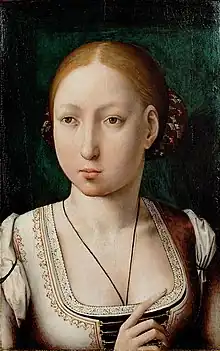 |
Philip I
| 22 July 1478 – 25 September 1506 (aged 28) | 27 June 1506 Castile | 25 September 1506 Castile | Husband of Joanna of Castile | Habsburg | %252C_%252C_Kunsthistorisches_Museum_Wien%252C_Gem%C3%A4ldegalerie_-_Philipp_der_Sch%C3%B6ne_(1478-1506)_-_GG_3872_-_Kunsthistorisches_Museum.jpg.webp) |
House of Habsburg (1516–1700)
Following the deaths of Isabella (1504) and Ferdinand (1516), their daughter Joanna inherited the Spanish kingdoms. However, she was kept prisoner at Tordesillas due to her mental disorder. As Joanna's son, Charles I (the future Holy Roman Emperor, Charles V), did not want to be merely a regent, he proclaimed himself king of Castile and Aragon jointly with his mother. Subsequently, the Castilian and Aragonese Cortes alleged oath to him as co-monarch with his mother. Upon her death, he became sole King of Castile and Aragon, and the thrones were left permanently united to Philip II of Spain and successors. Traditional numbering of monarchs follows the Castillian crown; i.e. after King Ferdinand (II of Aragon and V of Castile jure uxoris as husband of Queen of Castille Isabella I), the next Ferdinand was numbered VI. Likewise, Alfonso XII takes his number following that of Alfonso XI of Castile rather than that of Alfonso V of Aragon, the prior Spanish monarchs with that name.
| Portrait | Coat of arms | Name | Life | Reign | Titles | Claim |
|---|---|---|---|---|---|---|
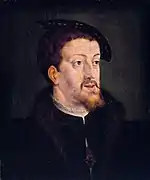 |
.svg.png.webp) |
Charles I (Emperor Charles V) Carlos I, el César Carlos |
February 24, 1500 – September 21, 1558 (aged 58) | March 14, 1516 – January 16, 1556 |
|
son of Joanna of Castile, grandson of Isabella I and Ferdinand II |
 |
.svg.png.webp) |
Philip II, the Prudent Felipe II, el Prudente |
May 21, 1527 – September 13, 1598 (aged 71) | January 16, 1556 – September 13, 1598 |
|
son of Charles I |
_-_Google_Art_Project.jpg.webp) |
.svg.png.webp) |
Philip III, the Pious Felipe III, el Piadoso |
April 14, 1578 – March 31, 1621 (aged 42) | September 13, 1598 – March 31, 1621 |
|
son of Philip II |
 |
.svg.png.webp) |
Philip IV, the Great, the Planet King Felipe IV, el Grande, el Rey Planeta |
April 8, 1605 – September 17, 1665 (aged 60) | March 31, 1621 – September 17, 1665 |
|
son of Philip III |
 |
.svg.png.webp) |
Charles II, the Bewitched Carlos II, el Hechizado |
November 6, 1661 – November 1, 1700 (aged 38) | September 17, 1665 – November 1, 1700 |
|
son of Philip IV |
Disputed claimant
| Portrait | Coat of arms | Name | Life | Reign | Titles | Claim |
|---|---|---|---|---|---|---|
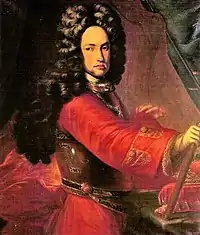 |
.svg.png.webp) .svg.png.webp) |
Archduke Charles of Austria, as Charles III Archiduque Carlos, (Carlos III) |
October 1, 1685 – October 20, 1740 (aged 55) | September 12, 1703 – July 2, 1715 |
|
great-grandson of Philip III |
In 1700 Charles II died. Charles' will named the 16-year-old Philip, the grandson of Charles' sister Maria Theresa of Spain and King Louis XIV of France, as his successor to the whole Spanish Empire.[1] Upon any possible refusal of the undivided Spanish possessions, the Crown of Spain would be offered next to Philip's younger brother Charles, duc de Berry, or, next, to Archduke Charles of Austria.[1]
Archduke Charles of Austria had a legal right to the Spanish throne due to the fact that Charles's father, Leopold I, Holy Roman Emperor, was the son of Charles' aunt Maria Anna of Austria, but Philip still had the better claim because Philip's grandfather, King Louis XIV of France, was the son of Charles' aunt Anne of Austria, the older of the sisters of Philip IV. However, Philip IV had stipulated in his will the succession should pass to the Austrian Habsburg line, and the Austrian branch also claimed that Maria Theresa of Spain, Philip's grandmother, had renounced the Spanish throne for herself and her descendants as part of her marriage contract. This was countered by the French claim that it was on the basis of a dowry that had never been paid.[2]
Thus, the war broke out and Archduke Charles was proclaimed king of Spain, as Charles III, opposite to Philip V.[3] Charles renounced his claims to the Spanish throne in the Treaty of Rastatt of 1714, but was allowed the continued use of the styles of a Spanish monarch for his lifetime. Philip ascended the Spanish throne but forever renounced his claim to the throne of France for himself and his descendants.[4]
House of Bourbon (1700–1808)
| Portrait | Coat of arms | Name | Life | Reign | Titles | Claim |
|---|---|---|---|---|---|---|
 |
_Version_with_Golden_Fleece_and_Holy_Spirit_Collars.svg.png.webp) |
Philip V, the Spirited Felipe V, el Animoso |
December 19, 1683 – July 9, 1746 (aged 62) | November 16, 1700 – January 14, 1724 (abdicated in favor of his son) |
King of Spain | great-grandson of Philip IV |
 |
Louis I, the Beloved, the Liberal Luis I, el Bien Amado, el Liberal |
August 25, 1707 – August 31, 1724 (aged 17) | January 14, 1724 – August 31, 1724 (ruled only 7 months before his death) |
son of Philip V | ||
 |
Philip V, the Spirited Felipe V, el Animoso |
December 19, 1683 – July 9, 1746 (aged 62) | September 6, 1724 – July 9, 1746 (reinstated on death of his son) |
father of Louis I | ||
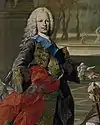 |
Ferdinand VI, the Learned, the Just Fernando VI, el Prudente, el Justo |
September 23, 1713 – August 10, 1759 (aged 45) | July 9, 1746 – August 10, 1759 | son of Philip V | ||
 |
Charles III, the Enlightened, the King-Mayor Carlos III, el Político |
January 20, 1716 – December 14, 1788 (aged 72) | August 10, 1759 – December 14, 1788 | |||
.jpg.webp) |
Charles IV, the Hunter Carlos IV, el Cazador |
November 11, 1748 – January 20, 1819 (aged 70) | December 14, 1788 – March 19, 1808 | son of Charles III | ||
_by_Goya.jpg.webp) |
Ferdinand VII, the Desired, the Felon King Fernando VII, el Deseado, el Rey Felón |
October 14, 1784 – September 29, 1833 (aged 48) | March 19, 1808 – May 6, 1808 | son of Charles IV |
House of Bonaparte (1808–1813)
The only monarch from this dynasty was Joseph I, imposed by his brother Napoleon I of France after Charles IV and Ferdinand VII had abdicated. The title used by Joseph was King of the Spains and the Indias, by divine grace and the Constitution of the State. He was also later given all of the titles of the previous kings. A government in opposition to the French was formed in Cádiz on 25 September 1808, which continued to recognize the imprisoned Ferdinand VII as king. This government was diplomatically recognized as the legitimate Spanish government by Britain and other countries at war with France.
| Portrait | Coat of arms | Name | Life | Reign | Titles | Claim |
|---|---|---|---|---|---|---|
 |
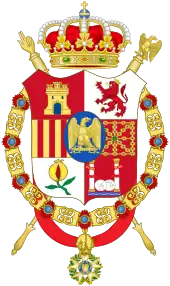 |
Joseph I, the Intruder, Bottle Joe José I, Pepe Botella |
January 7, 1768 – July 28, 1844 (aged 76) | June 6, 1808 – December 11, 1813 |
|
no relationship, appointee and elder brother of Napoleon Bonaparte |
House of Bourbon (1813–1868; first restoration)
Charles IV's eldest son was restored to the throne. Again the title used was king of Castile, Leon, Aragon,… by divine grace.
| Portrait | Coat of arms | Name | Life | Reign | Titles | Claim |
|---|---|---|---|---|---|---|
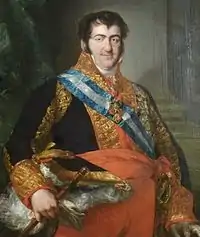 |
_Version_with_Golden_Fleece_and_Order_of_Charles_III_Collars.svg.png.webp) |
Ferdinand VII, the Desired, the Felon King Fernando VII, el Deseado, el Rey Felón |
October 14, 1784 – September 29, 1833 (aged 48) | December 11, 1813 – September 29, 1833 (restored to power by Napoleon) | King of Spain | son of Charles IV |
 |
Isabella II, the One with the Sad Destinies Isabel II, la de los Tristes Destinos |
October 10, 1830 – April 10, 1904 (aged 73) | September 29, 1833 – September 30, 1868 | daughter of Ferdinand VII |
House of Savoy (1870–1873)
After the Spanish Revolution of 1868 deposed Isabella II, there was established a provisional government and a regency headed by Francisco Serrano y Domínguez, who acted as Head of State, from October 8, 1868 until December 4, 1870 while it was requested a new monarch. Amadeo I was elected as king and the new title used was King of Spain, by divine grace and will of nation.
| Portrait | Coat of arms | Name | Life | Reign | Titles | Claim |
|---|---|---|---|---|---|---|
 |
_Golden_Fleece_Variant.svg.png.webp) |
Amadeo I, the Gentleman King, Amadeo I, el Rey Caballero |
May 30, 1845 – January 18, 1890 (aged 44) | December 4, 1870 – February 11, 1873 | King of Spain | descendant of Philip II (through his grandson Thomas Francis) and of Charles III (through his son Ferdinand I of the Two Sicilies and his daughter Maria Luisa) |
First Spanish Republic (1873–1874)
The First Spanish Republic started with the abdication as King of Spain on February 10, 1873 of Amadeo I, following the Hidalgo Affair, when he had been required by the radical government to sign a decree against the artillery officers. The next day, February 11, the republic was declared by a parliamentary majority made up of radicals, republicans and democrats. It lasted twenty-three months.
Presidents of the Republic
| Portrait | Coat of arms | Name (Birth–Death) |
Term of Office | Political Party | |
|---|---|---|---|---|---|
 |
.svg.png.webp) |
Estanislao Figueras (1819–1882) |
February 12, 1873 | June 11, 1873 | Federal Democratic Republican Party |
 |
Francesc Pi i Margall (1824–1901) |
June 11, 1873 | July 18, 1873 | ||
.jpg.webp) |
Nicolás Salmerón y Alonso (1838–1908) |
July 18, 1873 | September 7, 1873 | ||
.jpg.webp) |
Emilio Castelar y Ripoll (1832–1899) |
September 7, 1873 | January 3, 1874 | ||
.jpg.webp) |
Francisco Serrano 1st Duke of la Torre (1810–1885) |
January 3, 1874 | December 30, 1874 | Conservative faction | |
Kingdom of Spain (1874–1931)
House of Bourbon (1874–1931; second restoration)
Isabella II's eldest son was restored to the throne. Constitutional king of Spain. Between the death of Alfonso XII and the birth of Alfonso XIII, there was a period of seven months where the pregnant Queen Maria Christina served as Head of State with the title of Regent for her daughter Maria de las Mercedes, who was declared to be "Queen in Name" until the gender of her baby sibling was known.
| Portrait | Coat of arms | Name | Life | Reign | Titles | Claim |
|---|---|---|---|---|---|---|
.jpg.webp) |
_Version_with_Golden_Fleece_and_Order_of_Charles_III_Collars.svg.png.webp) |
Alfonso XII, the Peacemaker Alfonso XII, el Pacificador |
November 28, 1857 – November 25, 1885 (aged 27) | December 30, 1874 – November 25, 1885 | Constitutional King of Spain | son of Isabella II |
.jpg.webp) |
_Version_with_Golden_Fleece_and_Order_of_Charles_III_Collars.svg.png.webp) |
Alfonso XIII, the African Alfonso XIII, el Africano |
May 17, 1886 – February 28, 1941 (aged 54) | May 17, 1886 – April 14, 1931 | son of Alfonso XII |
Second Spanish Republic (1931–1939)
The Second Spanish Republic was the system of government in Spain between April 14, 1931 when Alfonso XIII left the country following a period of social unrest after the collapse of General Primo de Rivera's dictatorship a year earlier, and April 1, 1939 when the last of the Republican (republicanos) forces surrendered to the Nationalist (nacionales) forces led by Francisco Franco, at the end of the Spanish Civil War.
Presidents of the Republic
| Portrait | Coat of arms | Name (Birth–Death) |
Term of Office | Political Party | |
|---|---|---|---|---|---|
 |
-Flag_Variant.svg.png.webp) |
Niceto Alcalá-Zamora (1877–1949) |
December 10, 1931 | April 7, 1936 | Liberal Republican Right |
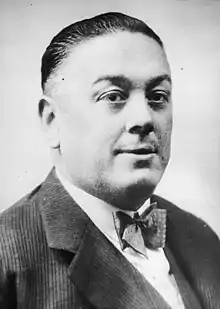 |
Diego Martínez Barrio (1883–1962) Interim |
April 7, 1936 | May 10, 1936 | Republican Union Popular Front coalition | |
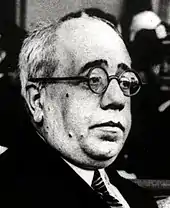 |
Manuel Azaña (1880–1940) |
May 10, 1936 | March 3, 1939 | Republican Left Popular Front coalition | |
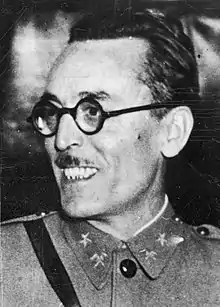 |
Segismundo Casado (1893–1968) Interim |
March 4, 1939 | March 13, 1939 | Republican Army National Defence Council | |
 |
José Miaja (1878–1958) Interim |
March 13, 1939 | March 27, 1939 | ||
Spanish Republican government in exile (1939–1977)
Presidents in exile
| Portrait | Coat of arms | Name (Birth–Death) |
Term of Office | Political Party | |
|---|---|---|---|---|---|
 |
-Flag_Variant.svg.png.webp) |
Diego Martínez Barrio (1883–1962) (Official interim successor of Azaña for being president of the Congress and an important figure for most of the non-communist anti-Franco forces but for his enmity with Juan Negrín he did not take office until 1945). |
March 4, 1939 | August 17, 1945 | Republican Union |
 |
Juan Negrín (1892–1956) (Prime Minister in the exile until the proclamation as president of Diego Martínez Barrio, who dismissed him). |
31 March 1939[5][6] | August 17, 1945 | Republican Union (Popular Front) | |
 |
Diego Martínez Barrio (1883–1962) |
August 17, 1945 | January 1, 1962 | Republican Union | |
 |
Luis Jiménez de Asúa (1889–1970) |
January 1, 1962 | November 16, 1970 | Spanish Socialist Workers' Party | |
 |
José Maldonado González (1900–1985) |
November 16, 1970 | July 1, 1977 | Republican Left | |
Francoist Spain (1936–1975)
On October 1, 1936 General Francisco Franco was proclaimed Head of State (Caudillo) in parts of Spain controlled by Nationalist (nacionales) forces after the Spanish Civil War broke out. After the end of war on April 1, 1939 General Franco took control of the whole of Spain. In 1947, Franco proclaimed the restoration of the monarchy, but did not allow the pretender, Juan de Borbón, Count of Barcelona, to take the throne. In 1969, Franco declared that Juan Carlos, styled as the Prince of Spain, the Count of Barcelona's son, would be his successor. After Franco's death in 1975, Juan Carlos succeeded him as the King of Spain.
| Portrait | Coat of arms | Name (Birth–Death) |
Term of Office | Political Party | ||
|---|---|---|---|---|---|---|
| Head of State (Caudillo) | ||||||
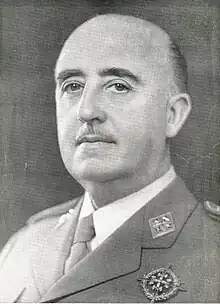 |
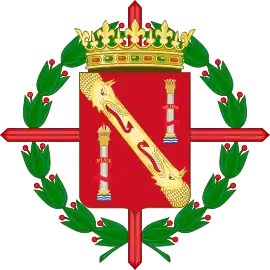 |
Francisco Franco (1892–1975) |
October 1, 1936 | November 20, 1975 | No party (Links to military and National Movement) | |
| President of the Regency | ||||||
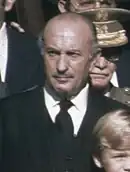 |
.svg.png.webp) |
Alejandro Rodríguez de Valcárcel (1917–1976) |
November 20, 1975 | November 22, 1975 | National Movement | |
Kingdom of Spain (1975–present)
House of Bourbon (1975–present; third restoration)
Alfonso XIII's claim descended (due to his two eldest sons' renunciations) to his third son, Infante Juan, Count of Barcelona, who was passed over in favour of his eldest son, whose title became King of Spain. The Count of Barcelona renounced his claims in favour of his son in 1977, two years after Franco's death and Juan Carlos's accession.
Juan Carlos abdicated in favor of his son Felipe VI, who became King on 19 June 2014, with Felipe's oldest daughter Infanta Leonor next in succession.[7]
| Portrait | Coat of arms | Name | Life | Reign | Titles | Claim |
|---|---|---|---|---|---|---|
.jpg.webp) |
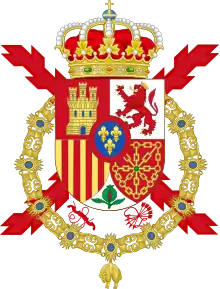 |
Juan Carlos I | January 5, 1938 | November 22, 1975 – June 18, 2014 | King of Spain | Grandson of Alfonso XIII, through his third son, Infante Juan, Count of Barcelona |
_Inauguraci%C3%B3n_de_FITUR_2018_(39840659951)_(cropped).jpg.webp) |
 |
Felipe VI | January 30, 1968 | June 19, 2014 – present | Son of Juan Carlos I |
See also
- Monarchy of Spain
- War of the Spanish Succession
- President of the Republic (Spain)
- Prime Minister of Spain
- Carlism – about pretenders who have tried to substitute the Isabelline monarchs.
References
- Kamen, Henry. "Philip V of Spain:: The King who Reigned Twice", p.6. Published by Yale University Press, 2001. ISBN 0-300-08718-7
- Durant, Will. "The Age of Louis XIV", p.699. Simon and Schuster, New York 1963.
- He was proclaimed in Vienna ("Charles VI.". Encyclopædia Britannica. Vol. 5 (11th ed.). 1911. p. 905.), and also in Madrid in the years 1706 and 1710.
- Kamen, Henry. "Philip V of Spain:: The King who Reigned Twice", p.158. Published by Yale University Press, 2001. ISBN 0-300-08718-7
- Herrerín López, Ángel (2007), El dinero del exilio: Indalecio Prieto y las pugnas de posguerra (1939-1947), Siglo XXI de España Editores, pág.3
- Romero Samper, Milagrosa (2005), La oposición durante el franquismo, Encuentro, pág.91
- "Leonor becomes a crown princess". El Pais. June 4, 2014.